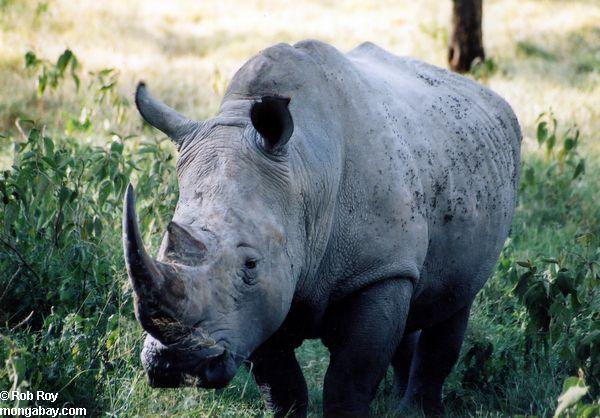Three hundred and thirty-three rhinos were killed in South Africa last year, the highest number yet. Ten of the rhino were black rhinos, which are listed as Critically Endangered by the IUCN Red List, the rest were white rhinos, listed as Near Threatened. In total South Africa has over 20,000 rhinos.
The record level of poaching is being committed by well-equipped criminal networks. In South Africa, poachers are employing helicopters, night-vision, tranquilizers, and weapons fitted with silencers often allowing them to drug a rhino, cut off its horn, and leave it to bleed to death from the wound before it is found.
“Only a concerted international enforcement pincer movement, at both ends of the supply and demand chain, can hope to nip this rhino poaching crisis in the bud,” said Tom Milliken, Director of TRAFFIC’s East and Southern Africa program, in a news release.
Rhino poaching has a human toll as well. Both poachers and park rangers, who defend the animals, have lost lives. Last week five suspected rhino poachers were killed in South Africa’s largest park, Kruger, during a shootout with the nation’s elite police force. Three suspects got away.
Rhinos are primarily being poached for an illegal and booming trade in Asia. Powdered rhino horn is used in traditional Asian medicine, although there is no scientific evidence that the horns contain any curative elements. Fueled by a trade that is both illegal and underground, last year it was estimated that one kilo of rhino horn was worth approximately $60,000, nearly $20,000 more than a kilo of gold.
Poaching, along with habitat loss, has pushed four of the world’s five rhino species toward extinction, three of these species are considered Critically Endangered, including Africa’s black rhinoceros, of which around 4,000 survive. Asia’s rhinos are even worse off: there are less than 50 adult Java rhinos in the world and less than 250 adult Sumatran rhinos.

A black rhino is Kenya. Photo by: Rob Roy.
Related articles
Alleged rhino horn dealer takes his own life
(11/10/2010) The illegal trade in rhino horn doesn’t just end in the deaths of thousands of rhinos. Humans, too, often lose their lives in the trade. Both those poaching rhinos and those protecting them, such as park rangers, have been killed in gun battles. But the trade ruins lives in many ways: yesterday, Tommy Fourie, 51, who allegedly sold 36 rhino hunters to a game farmer, shot himself with a hunting rifle in South Africa.
Already illegal, one man tests poisoning rhino horn too
(07/28/2010) Given the epidemic of rhino poaching across Africa and Asia, which has placed four out of five species in jeopardy of extinction, one fed-up game manager wants to take the fight beyond the poachers to the consumer. Ed Hern, owner of the Lion and Rhino Park near Johannesburg, told South Africa’s The Times that he has begun working with a veterinarian on injecting poison into a rhino’s horn to consumers. He told The Times that people who consumed poisoned rhino horn “would get very sick or die”.
Elle MacPherson promotes consumption of illegal rhino horn [warning: graphic image]
(07/02/2010) Despite a number of scientific studies showing that rhino horn has no curative properties, supermodel, entrepreneur, and recent host of Britain’s Next Top Model, Elle Macpherson, says she ingests powdered rhino horn because: ‘[it] works for me’. In an interview with The Sunday Times via Twitter, Elle Macpherson says the illegal substance tastes like ‘crushed bone and fungus’.